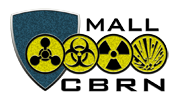About the project
Creation of CBRNE protection system for large area shopping malls (Mall-CBRN).
Chemical and biological and radiological threats are currently emerging. The European society must take into consideration the associated risks. The use of any of the types of biological, chemical or radiological agents in various acts of terrorism may open the door for the possibility of destabilization of the European Union and lead to undermining economic stability, public security, and integrity in the EU community. The motive of this type of action may be of political, religious, economic or national basis. Potential targets that are vulnerable to be found in the epicentre of the attack include large gatherings of people, places of continuous movement of people. These two key features characterise the large shopping malls which are “perfect” soft target to perform attack on large number of people and to cause a panic in public spaces.
Taking those facts into consideration the Mall-CBRN project is aiming at creating prevention, response and consequence management mechanisms and interoperable capabilities, recommendation for equipment for internal security service as well as algorithms of cooperation with services in cases of CBRN acts in shopping centres also applicable to other large scale venues.

Project long-term goal is increasing safety of European Union society using daily the services of large-area shopping malls by creating comprehensive program of prevention and response to CBRNe threats.
A multidisciplinary team of experienced specialists representing various fields of expertise, will share their experience and transmit professional knowledge of dealing with CBRNe risks, on shopping malls areas. The project represents a novel concept of prevention against CBRNe threats, focused on specific areas which have not been prepared for this type of acts so far.
Project will focus on:
- Gaps analysis in security systems of shopping malls by consortium experts and advisory team members to check all procedures, equipment and knowledge of internal security services of selected shopping malls in the EU territory.
- Identification of most likely scenarios of terrorist acts with CBRNe agents in the area of shopping malls. Creating the list of most possible threats and define the terms for best prevention measures.
- Preparing the recommendations for response procedures to CBRN terrorist act for shopping malls internal security services. This objective will include:
- special communication materials with basic knowledge as well as procedures of recognition and response to CBRNe hazards.
- short guidelines dedicated to better communication and cooperation
between shopping malls internal security services and law enforcement
services arriving at the action scene.
- Equipment recommendations for detection of CBRNe hazards, specially adjusted to the level of knowledge and skills of internal security services as well as matching specification of places.
- Series of CBRNe trainings for representatives of shopping malls who will get knowledge to implement developed CBRNe protection system in own facilities. These trainings will be carried out by consortium CBRNe experts as well as the representatives of law enforcement institutions.
The work in the project will be organized in 7 work packages (WP):
WP1: Management and Coordination of the Action
WP2: Gaps analysis and mapping
WP3: Identification of most likely CBRNe scenarios
WP4: Recommendation for prevention and response procedure to CBRNe terrorist acts
WP5: Food defence
WP6: Piloting and testing
WP7: Dissemination and sustainability
Duration: 01/11/2019 –31/10/2022
Total cost: € 2 161 657,87
Call: InternalSecurity Fund Police ISFP-2018-AG-CT-PROTECT
Co-funded by the Internal Security Fund of the European Union This project has been funded with support from the European Commission. This publication [communication] reflects the views only of the author, and the European Commission cannot be held responsible for any use which may be made of the information contained therein Grant Agreement No. 861643


